by Malcolm Woods
When it comes to batteries, there is no one-size-fits-all for a solar system. Every application is going to be different. Honestly, this is the answer that I give to most people when they are installing a solar panel.
For solar systems, batteries can be a really complicated purchase. There are thousands of options with different voltage, amp-hours, and different types. And they don't come cheap.
Batteries may be the most important thing that you spend money on in a solar system. Choosing the best solar deep cycle battery isn't easy. However, I can simplify the process for you.
Well, more like complex information with some simple answers. Price is the biggest deciding factor here, and the best ones are the ones that you can afford.
For a comfortable off-grid living, deep cycle solar batteries are still the center of every off-grid solar system. They provide the consistency and reliability you need for everyday usage.
Contents
Follow This Table For Quickly Select A Product
| Product Image | Name | Editor's Rating | Price |
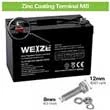 | Weize 12V 100AH Deep Cycle AGM SLA VRLA Battery | 4.6 / 5.0 | Price Check |
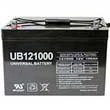 | Universal Power Group 12V 100Ah AGM SLA | 4.5 / 5.0 | Price Check |
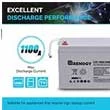 | Renogy Deep Cycle AGM Battery 12 Volt 100Ah | 4.8 / 5.0 | Price Check |
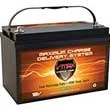 | Vmaxtanks AGM 12V 125Ah SLA Rechargeable | 4.8 / 5.0 | Price Check |
 | Battle Born LiFePO4 Deep Cycle Battery | 4.7 / 5.0 | Price Check |
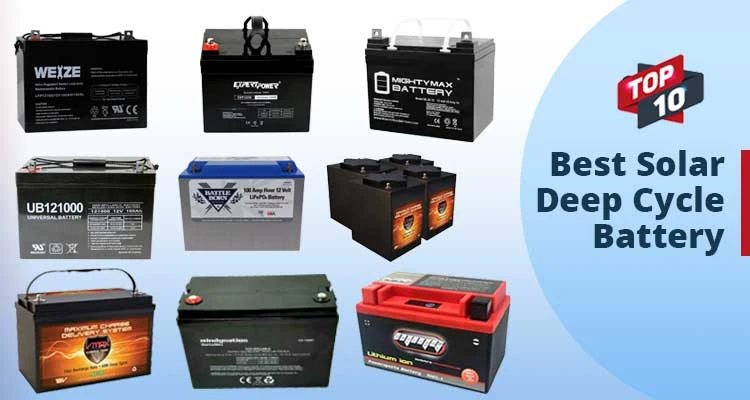
Solar batteries are essentially deep cycle batteries that are capable of storing energy provided by the solar panels or other renewable energy sources for later use. They might look like a car a battery, but they have different applications.
I know things are already getting complicated, but as you go through our solar deep cycle battery guide, trust me, everything will become smooth as butter.
Your solar batteries will be working hard because everything comes and goes from the battery bank, and that's why it's important to go with the most trusted brands. Here is a list of top 10 batteries that should come in handy for both full-time off-grid goers and intermittent usage.

If you want the best bang for your buck, sealed lead acid 12V battery for your solar system, look no further than the Weize LFP12100. This deep cycle battery is rated at 100 Amp-hour that features AGM (Absorbent Glass Mat) technology as well as a valve regulated design.
This means you can use it in an indoor environment as well as in an enclosed space because there is virtually no maintenance required on your part.
Once you install it, you can leave it there. It is usable in both cyclic and float applications, and you can expect excellent service life and exceptional performance.
The battery features a heavy-duty, state of the art calcium-alloy grid that provides superior performance at a much affordable price.
To make the installation process a breeze, it comes with washers, bolts, nuts, screws, and also lock washers for the poles as well as protective caps for them.
Long story short, you are getting good specs at a great price, and since it is sealed, you don't need any maintenance.
It's a dependable product that charges easily and will hold a lot of charges. You can use it for off-grid solar panel applications, trolling motor, golf cart, portable motor, and many more.
Highlighted Features
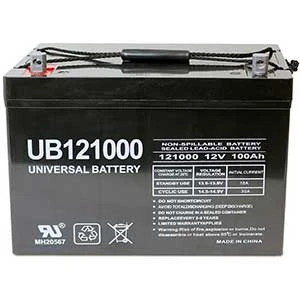
This is an absolute stellar unit from Universal Power Group that will also give you good value for your money.
It's a 12V 100 Amp-hours battery with SLA, AGM chemistry. This means it is maintenance-free and you won't have to worry about any leakage.
The best part about a sealed battery is that you can mount them in any position you like, and they have better resistance to shocks and vibrations.
For the price, there is no doubt that this a good quality battery for any small off-grid solar system.
Before you hook it up, make sure to run a 100AH battery test first to see if the unit you are receiving is in a healthy condition.
A healthy battery will 12.4V or somewhere around that number. Also, when you are buying more than one of these, keep in mind that you will only get 50% of their full capacity.
Typically, any lead-acid batteries, in general, will give you only half of its full capacity in order to preserve battery life.
If your solar regular is set up to utilize 50% power, then you will roughly get 600 watts per battery (12V * 100AH = 1200 watts/3 = 600 watts).
Highlighted Features
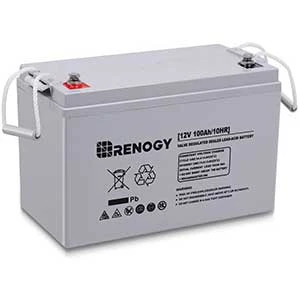
For an off-grid application, a battery pack that is designed specifically for solar systems should be your top priority.
This AGM, deep cycle battery from Renogy, is specifically designed for solar use. It's a high-performance battery that requires no maintenance thanks to its spill-proof and leak-proof design.
This battery is suitable for daily use, or you can use it for backup power as it is capable of instantly discharging high-current.
With two of these hooked up in parallel, they will be more than enough to power your camper. Pair this battery with Renogy's solar panel to get maximum performance.
Apart from solar systems, you can use it for common uses like golf carts, garden tools, electric vehicles, electronics, lawn equipment, and many more.
When installing, keep in mind that these batteries are on the heavy side. They are typically heavier than most standard deep cycle batteries.
The battery comes with terminal bolts, and the size of them is 5/16″ or 8 mm or 0.314 inches in decimal. I listed them in various formats because their official website doesn't have this info labeled clearly.
Thank me later. As an additional component, you can also buy the Renogy 500A battery monitor.
Highlighted Features
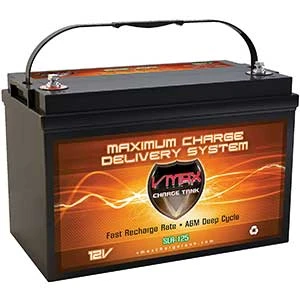
Anyone making their own DIY solar panel setup should definitely consider getting one or two of these AGM deep cycle batteries.
Although the VMAXSLR125 isn't your mainstream solar battery, the design and application are the same. In float mode, you can expect 4 - 8 years of life span and superior performance.
You can mount this 12V 125Ah battery anywhere in your home. The battery is suitable for indoor use as it doesn't contain any free-roaming fluids.
Since this one has minimal venting, you can keep this battery inside. However, AGM batteries are not suitable for outdoor use as they are very sensitive to cold weather.
The battery holds up to the elements really well thanks to the custom-made military-grade plates and specs.
Get 3 of them for a 500W solar system to power an entire house. Once you install them, you don't have to worry about any maintenance.
Since these batteries utilize AGM technology, they will charge faster and retain charge for a long time. It is highly dense, which is a good indicator.
This means they will hold a tremendous amount of charge, and you will also be able to jump-start things if you ever needed to.
Highlighted Features
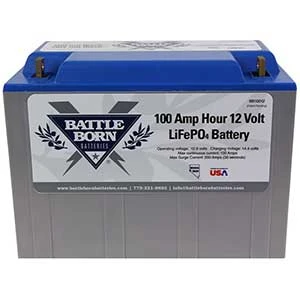
We are almost halfway through this list, and so far, you have only seen AGM batteries. This one, however, is kind of different.
Although it's a 12V 100 Amp-hour battery, it is using LiFePO4. It's a deep cycle lithium-ion battery that can easily outperform any lead-acid and Gel batteries.
To make it even better, it comes with built-in BMS. This stands for a battery management system, which is literally the brains of this battery.
It will protect the unit from common failure causes such as ground faults or temperature volatility. It works as a shut-off system for the battery by regulating and calculating power.
Since it is a lithium-ion battery, you can expect it to last 3000 or more cycles. If you are thinking about a grid-tie or an off-grid solar panel installation, this deep cycle battery will be worth every penny. This one also charges much faster than a lead-acid battery.
Compared to other technologies used in solar batteries, this one easily takes the cake for being the most cost-effective solution.
I know the cost is way more than what you are used to seeing but thinking about the long-term advantage. It clearly has the longevity to pay for itself.
Highlighted Features
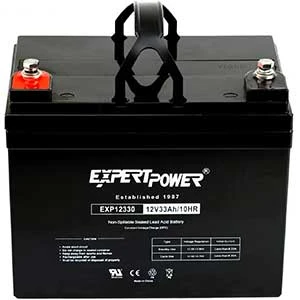
For all intents and purposes, this deep cycle battery ExpertPower might look underpowered, but it is worth every penny.
Keep in mind that it is a 33-amp hour battery. For the application that you are buying this battery for, make sure that it doesn't exceed 33 amps.
It will be a perfect option if you plan on using it on a small pontoon boat or a small canoe. The unit weighs only 22 pounds, which makes it ideal for small applications.
For example, if your trolling motor is 6 pounds and has a thrust of 20 pounds, this battery can easily power that motor for hours. This battery should only be used for small solar systems that will only power small electric appliances.
It's a sealed battery that utilizes AGM technology for deeper discharge and a faster charge rate. It also has a wider temperature range than most standard solar battery which means this will last a long time.
Highlighted Features
If you are tight on a budget and want to get something that is more affordable, the ML35-12 SLA from Mighty Max Battery can be considered as a good choice. This is a sealed lead-acid battery with a 35 Amp-hour rating.
The 12-volt battery can be mounted in any position thanks to the SLA design. It has a spill-proof design, and while it's one lower end of the spectrum, you will still get reliable performance, high discharge rate, longer service life, ability to operate at various temperatures as well as deep discharge recovery feature.
This spill-proof design makes this one a maintenance-free battery. For installation, you won't get any mounting accessories or wire harnesses.
You have to buy them separately. Truth be told, there are better batteries at a similar price point that will offer more than what this offers.
However, at this price, finding something smaller with a good amp hour rating is tough. Keep the amps rating in mind before you buy one of these. It is okay for a small trolling motor but won't do a good job for golf carts.
Highlighted Features
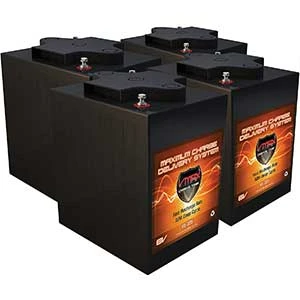
The solar series batteries from VMAXTANKS are ideal for every type of energy storage solution. Whether it's a small backup solar power system or a full-time off-grid application, these batteries are more than capable of storing solar energy and giving you power whenever you want.
These AMG deep cycle batteries are sealed for maintenance-free usage and feature military-grade custom made plates.
These ensure you get reliable performance, longer-lasting battery life, and excellent deep cycle capabilities. The batteries are also designed to withstand the most demanding applications.
It comes in a pack of 4 batteries, and each of them is 6 volts and rated at 225 Amp-hours. Whether you want to use them for emergency power backup or daily use, these batteries can easily withstand repeated cycles.
You can mount them anywhere and, in any position, thanks to the leak-proof design.
Maintenance-free usage is bliss for any solar system owner. These batteries will give you just that. You don't have to add water or check for electrolyte levels.
Finally, service life is what makes them worth buying. They are rated to provide one of the highest numbers of recharge and discharge cycles.
Highlighted Features
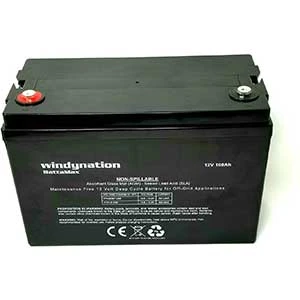
For an off-grid solar system, you will need a battery or a pack of batteries that are specifically designed to handle repetitive, deep discharges.
WindyNation's BattaMax series of batteries are a true deep-cycle that features AGM technology that makes them ideal for every type of off-grid power system.
The sealed 12V lead-acid battery is rated at 100 Amp-hour to provide off-grid power. It comes with heavy-duty plates and virgin lead for efficient power storage and extremely low discharge. The expected float life of this battery is about 10 years.
The non-spillable, sealed design makes it ideal for applications such as RV's, Telecommunications, Offshore Marine power, aerial work platforms, inverters, and many more.
Places like healthcare facilities, educational institutions, airports, shopping centers, etc. require the use of non-spillable batteries.
In places like these, the BattaMax series of batteries can also be used. Long story short, it's an ideal unit that is suitable for a wide variety of applications.
Highlighted Features
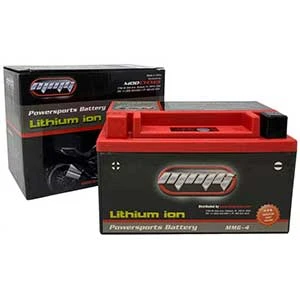
Weighing 1/3 of what a typical lead-acid battery weighs, this lithium-ion battery from MMG gives you not only superior performance but also an exceptional life cycle.
Where a lead-acid battery has only 150-300 duty cycles, the MMG YTZ10S Z10S provides more than 2000 cycles.
Since there is no acid inside, you won't have any leak problems. Lithium-ion batteries are somewhat costly because they are a new technology in the solar system era.
But these batteries have a faster recharge rate, low discharge rate, and they can perform at high temperatures.
Not only is it lighter than a lead-acid battery, but it also has a higher cranking amp. Where a standard lead-acid battery only has 10C, this one has 40C.
The best part about this unit is that it comes fully activated and fully charged from the factory. This means you can set it up and enjoy power output from the start.
To save energy, it has lower internal resistance and a stable discharge voltage. There is also a battery capacity indicator feature built-in that lets you know how much charge left in there. With 290 CCA, you can even jump-start car engines and generators.
Highlighted Features
This guide will provide you with all the information you will need to pick the right battery for your solar power system.
Having more solar panels will allow you to store electricity quicker, but if you can only store a few hours of power in your battery, then it doesn't help you too much on cloudy days.
Batteries are measured in amp-hours. More amp hours mean you can run more things for longer. This is the easiest part of this guide. Now that's out of the way, let me show you an example.
Suppose you have a laptop that takes 2.8 amps per hour and a fridge that takes about 3 - 5 amps per hour. My recommendation would be to use an online solar calculator to estimate how many amp-hours you would use daily.
Then purchase a battery with the highest amp hour rating that your budget allows. Make sure it can cover everything you plan on running via your solar power station.
Just having a good solar system installed won't be enough unless you have somewhere to store all that energy. This is where having the best deep cycle solar battery comes in handy.
If you are not connected to the utility grid, you will need to get deep cycle batteries for off-grid solar. Now, before I go to the main guide section, let me clean the basics first.
Solar batteries are essentially deep cycle batteries that are capable of storing energy provided by the solar panels or other renewable energy sources for later use. They might look like a car a battery, but they have different applications.
Car batteries aren't designed for prolonged, repeated discharges. However, a deep cycle battery can discharge for a long time.
Although batteries made for cars are also referred to as flooded lead-acid batteries, the main difference between them and the ones used for renewable energy is significant.
To make it simple, think of a car battery as a sprinter. They are meant to provide a lot of juice fast, and they don't last very long between charges. And they are also not meant to go very long between charges.
Think of it like a sprinter. They run fast races quickly while burning more energy in the process, whereas deep cycle batteries for solar-powered systems are meant to be drained slowly over time and meant to be drained much further down.
You drain them down to 50% or more without facing any problem. However, if you drain a typical car battery more than 10%, or let's say if they go below 11 volts, they are basically dead.
You won't be able to revive them because they are permanently damaged. A renewable energy dedicated type of battery used for a battery bank is like marathon runners.
These batteries are meant to go a long time over and over again. These deep cycle batteries are what you really want to use when you build a certain size of a solar system.
Long story short, deep cycle batteries are meant to be discharged and charged repeatedly, and that's why they are used for solar energy systems.
You might want to buckle your seatbelt cause it's going to be a long ride. Let's get the obvious factor out of the way first. There is no one best solar battery for every solar system.
Amps, cost, capacity are just a few of the important factors that will finalize your purchasing decision. What is really important is understanding the types.
For a long time, solar systems have been relying on lead-acid batteries, and a lot of users still prefer to use them.
However, with the advancement of technology in battery cells, newer types of batteries are now available in the market.
For a long time, lead-acid batteries were pretty much your only option if you wanted to install a solar power station.
These individually designed batteries often required a significant installation time and a lot of maintenance afterward. There is also the cost factor.
However, now there are newer types of batteries that are cost-efficient, smaller in size, require no maintenance, and last longer.
In this section, I'm going to go through some of the most used battery types when it comes to solar systems. It's important that you go through all of them because each of them has its own pros and cons.
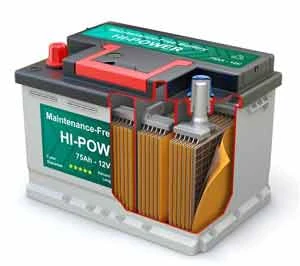
Think of them as multiple car batteries strung together. Flooded lead-acid batteries were once the only go to battery option for home solar systems. Mainly off-grid solar power stations relied heavily upon them.
Some are still in use as of today. Folks back in the day used to call them wet cells. By stringing a couple of these batteries together, you can increase the capacity.
The main reasons why wet cells were widely used are because of their safety, proven reliability, and low-upfront cost.
Seems good so far, but what's the catch? Well, these batteries required a lot of maintenance because of corrosion, and they are also bigger in size. You can only mount them upright.
They don't have the sealed design that you are used to seeing on most modern solar batteries. You also need to keep them well ventilated. Now, that's a lot of maintenance just for one of them.
This is the main reason why AGM batteries are replacing them. I'll talk more about AGM technology in the upcoming section. If you are the type of person that enjoys taking care of your solar system, flooded lead-acid batteries can prove to be very useful.
However, not all of us have the time to do that. For those of you that forget to charge their smartphones regularly, this type isn't for you.
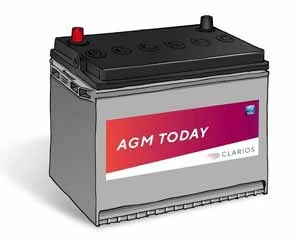
AGM stands for Absorbent Glass Mat technology. It's a type of lead-acid battery that has a sealed design and looks a lot similar to a flooded lead-acid battery.
However, AGMs have better reliability, and they are lighter in weight.
This technology became widely popular in the early 1980s because of its leak-proof design. They were used in vehicles, UPS, and military aircraft for their no-maintenance and reliable performance.
The batteries have a fiberglass mat on top that absorbs the electrolytes, and because of them, they can be kept indoors.
Compared to other types of batteries, AGM cells can self-discharge slowly and can handle higher temperatures. They also have lower internal resistance compared to flooded cells.
AGM batteries are relatively lightweight; they are not inclined to heat up thanks to lower internal resistance, non-hazardous, thus making them more environmentally friendly, and they can hold a static charge for longer durations. The best part is these batteries are resistant to cold temperatures.
Although the cost of these batteries is a tad bit more expensive than a flooded lead-acid battery, they do have a higher life cycle, which makes them perfect for off-grid solar stations.
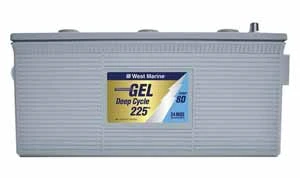
In terms of specs, Gel batteries predate AGM batteries in a lot of ways. But you won't see much of them on the market. Why? Because these batteries have some serious downsides.
At first glance, these batteries will easily overpower an AGM battery in terms of the life cycle, power storage, discharge capability, etc. And they are also specifically designed for deep cycle applications.
So, why are they losing market share to AGM technology? The main reason is because of their very narrow charging profile.
You see, the cells of Gel batteries are sturdier because, for the electrolytes, they use fumed silica as a thickening agent.
This makes the cells more vicious, thus preventing leakage when damaged. The batteries also have a slightly higher discharge rate than flooded batteries have, and they are ventless. So far, so good.
It gets even better. Similar to an AGM battery, GEL batteries don't need any maintenance, and they are also resistant to shock and vibration. Also, because the cells have higher boiling points, they tend to handle higher temperatures much better.
Now, because of their narrow charge profile, they tend to get damaged easily. If you charge them inappropriately, you can and will end up damaging them by overcharging.
Since the electricity production on the solar system is variable, it is very easy to accidentally destroy Gel batteries, although this can be prevented if you use a charge controller, which will only add up the initial upfront cost.
Speaking of upfront cost; Gel batteries are costlier, but they don't have a better amp-hour capacity.
However, you will get a higher life cycle, and if you plan on going all out, make sure to get a proper solar charge controller.
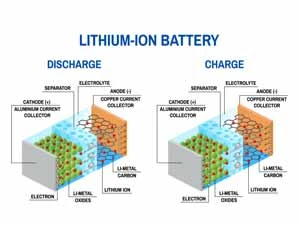
For a home solar power station, lithium-ion batteries are better in every way. Not only do you get a higher life cycle, which is usually 10 - 20 times more than what an AGM or a sealed lead-acid battery will offer, you will also get ten times for lifespan.
A standard lithium-ion battery will usually have 3000 to 5000 life cycles. On the other hand, you will only get 300 - 500 life cycles on a sealed lead-acid battery.
That's not all, lithium-ion batteries that are made for deep cycle applications like solar systems use LiFePO4 (Lithium Iron Phosphate).
These batteries won't burn, explode, and they are perfectly safe. The best part is, they will remain stable while providing reliable performance and maintenance-free.
Thanks to the nano-scale phosphate cathode material, lithium-ion batteries provide good electrochemical performance and have low resistance.
It also gives the batteries good thermal stability, long cycle life, high-tolerance, and enhanced safety.
As a result, they can harvest more energy from solar panels and discharge efficiently, which makes them ideal for solar applications.
Whether it's a small or large grid-tied or off-grid system, lithium-ion batteries are a good choice.
The only disadvantage is their high price tag. They are really expensive, and some models can cost 4 to 5 times a standard lead-acid solar battery.
However, in recent years we are seeing a steady decrease in price as the technology is getting more affordable.
So, what is the best solar battery type?
Long story short, if you have some cash to spare, go with lithium-ion batteries. The technology is fairly new, and they cost a lot more than sealed lead acid or flooded lead-acid battery. But you will get better power storage, a better lifetime, and the best is no maintenance.
If you are on a tight budget, the second-best option will be flooded lead-acid batteries. These are by far the cheapest ones out there but with a shorter life cycle, and they also require some maintenance.
If you want the best bang for your buck battery, go with sealed lead-acid batteries. AGM chemistry is preferable as it doesn't require any maintenance and as more life cycles than a sealed lead-acid battery.
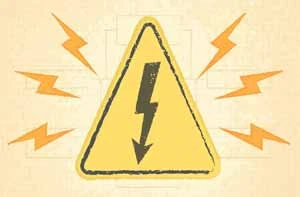
One minor detail that most first-time solar system installers forget is the voltage. We all know that the most standard and simplest setup is 12 volts. It is used in boats, RVs, and cars.
If you only need a small yet simple solar power solution, 12 volts should be more than enough.
However, a tiny 12V power inverter with a 12V DC system is almost impossible to upgrade if you want more power later on.
Nowadays, it's better to go with a 24V DC system because of the number of electronic appliances we use. Increasing the DC voltage will actually lower the cost, too, because you will only need to connect fewer modules in series.
This means you will have reduced voltage drop, fewer combiner boxes, and fewer connections and conductors to install. Increasing the voltage will also give you a lower current for the same amount of power while a smaller gauge-wire.
Consider going for 24 volts if you think you will need more than 500 watts of solar modules. Go for a 48V solar battery system if you plan on living completely off-grid.
That will also require a good solar charge controller. So, make sure you get that when you install a 48V system.
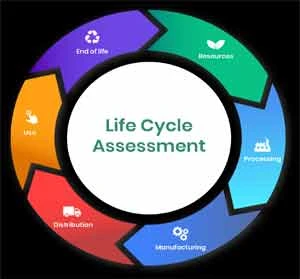
The cycle life of a battery is really important as it represents the overall performance life of a solar battery. How many times can you cycle that battery? Some batteries have a cycle range of about 300 - 500, while some can range up to 1650 cycles.
So, when you choose a battery, make sure to check the cycle life, get the specs on how many times you can cycle it. Because not all the batteries are the same, it's the failure and quality that you are looking for.
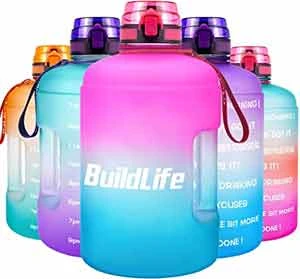
Another important point when choosing a component like a solar battery is the build quality. It refers to the chemical composition of the battery. Some will give you up to 12 years of build life, while some are meant to last only 3 - 5 years.
So, build life really represents the quality of the battery. Make sure to check the build quality and build your solar system based on that.
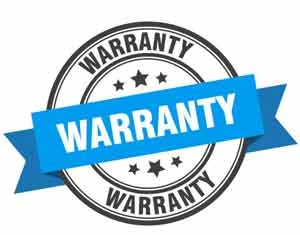
Last but not least, warranty. This is perhaps the most important aspect of them all. The length of the warranty period is a really good indicator of the overall quality of a battery. Generally, the longer the warranty, the better the battery.
The advantages of using a deep cycle solar battery for a solar power system are many. Here are some of them.
Batteries designed for deep cycle use often come with safety valves that will prevent battery cracks and explosions in the event of excessive gas production.
You can position/mount them in any position since the separator in AGM or Sealed batteries keep the electrolytes absorbed in a glass mat and in a fixed position.
You don't have to balance the charge or refill the water because, in the charging process, the produced hydrogen will get absorbed by the plates and reversed to electrolytes.
These batteries are ideal for high rate applications because of their low inner resistance. Because of that, they are capable of higher charging current and higher discharging for better performance.
AGM batteries, in specific have better cycle performance and long standby life. They also have a longer float charging time thanks to the lead-calcium alloy plates. These plates are also corrosion-resistant.
Because of the AGM separator, the electrolytes get trap inside. This also prevents positive plate dropping of active materials for maintaining consistent performance.
Lower self-discharge means you will get a longer shelf life. This is possible due to the special lead-calcium alloy used in the plates.
Even in extreme weather, a good deep cycle solar battery will be able to maintain peak performance. Since the plates prevent electrolyte from being frozen in low temperatures or getting evaporated at high temperatures, these batteries tend to keep on performing at their level best.
The truth is a lot of solar system owners don't even know how to properly take care of their batteries, and most of them end up killing these units.
Most of them will think that it's the result of a faulty battery. As a matter of fact, it is due to not maintaining and not using the product properly.
So, it's very important that you go through this section and follow the steps that I'm going to teach you.
Your deep cycle batteries are designed for deep cycling. This means the units are designed to slowly discharge over time. In simple terms, it means to have power drawn out of them slowly but constantly.
The other kind of batteries, like the ones used in cars, are starting style batteries or cranking batteries. They produce a lot of power at startup to start the engine of a car.
However, they designed not to have charge drawn out of them like a deep cycle battery over extended periods of time. They are designed to start a car and not for a portable power solution.
Now, the next step is to avoid discharging a deep cycle battery fully. These batteries have a limited number of discharge cycles, and it's not a good idea to fully discharge them and recharge them again. In this case, you will quickly run out of cycles and end up with a dead battery.
Cycling the battery or the depth of discharge is the most important thing when it comes to taking care of your battery. If you want your battery to last a long time, it's important to keep the discharge factor in mind.
The more power you take out of your battery or, the deeper you discharge, and if you keep on doing this more often, your solar battery won't last long. It will lead to shorter battery life.
A good practice is to take a small amount of power from the battery and recharge it again. This way, you can prolong the battery life by years. The one thing you want to avoid is discharging them till they are flat.
You will kill your battery if you don't have any protection measurements. Once it goes down to 0 volts, congrats, you have successfully killed your battery. It will also void your warranty.
Tips: A battery goes flat at 11.8 volts. This is the 0 volt that I was talking about earlier. That's why you should never discharge them below 11.8V.
When you are using your solar battery on a daily basis, make sure, the amount of power you draw out, you put it back in.
For example, if you are out camping and you've got a portable tv or fridge running, and that's draining power at nighttime, and the battery goes down a little bit.
Then you have to ensure in the daytime, the solar panel you have got is enough to refill the power that it has lost overnight and also run your appliances.
Sizing your solar battery bank depends on two things.
These two factors will determine how much power you need from the batteries.
For example, batteries will have a certain amp-hour or kWh rating. The easiest way to know how much energy you will need is by looking at your electricity bill.
You can also estimate daily energy consumption by calculation watt-hour. There is an appliance called to kill a watt meter that measures how much energy each of your appliances consumes.
Now, depending on the battery type, most of them will not give you 100% power. As a matter of fact, you will only be able to utilize 50% of their rated power. This is only applicable if you go with lead-acid batteries.
Gel or AGM batteries will allow you to utilize up to 75% of their rated power. On the other hand, lithium-ion batteries provide up to 90% of their rated power, but they are too costly.
Next up is the day of autonomy. You should keep in mind the potential days of autonomy when sizing your battery bank. Due to clouds or rain, there are certain times in the year where you won't get sufficient sun rays for your solar panels to fully charge the battery.
If this happens, your system should have enough storage capacity to run 3 -5 days without being charged.
If you are looking for the most cost-effective solution, a tried-and-true battery technology, currently, the most popular option for a solar system is a Flooded Lead Acid battery.
In my opinion, this is the best type for a couple of reasons. It has been around for a long time and has the lowest upfront cost with a typical lifespan of 5 -7 years.
However, the flip side is they will require some maintenance from time to time. You are going to have to check the levels of water inside the batteries. And you will also need to equalize them at least every 90 days.
There are also other things that you will have to do to stay on top of it to ensure the longevity of the battery. How hands-on do you really want to be?
If you want to go maintenance-free, there are two options - Sealed Lead Acid batteries and Lithium batteries. But they are way more expensive. A lot of it will come down to how you are with your equipment.
If you are the type of person that forgets to check the oil of your car or tends to forget things like that, you might want to stay away from flooded lead-acid batteries.
You will need a more maintenance free approach like the Sealed AGM or Lithium. There is no equalizing and no off-gassing. You don't even have to check water levels.
These are the type of batteries that you install and kind of forget about them. However, this level of maintenance-free technology that you are getting comes at a higher-price and might not be affordable for everyone.
With that being said, you need to consider how much work you are willing to put into your batteries vs. the cost of those different solutions.
If you want to save initial upfront cost, go with Seal lead-acid AGM batteries. They are reliable and require no maintenance.
It depends on the type of battery that you are using. Only flooded batteries need to be checked periodically to make sure the electrolyte levels are full. On the other hand, sealed lead-acid batteries and lithium-ion batteries don't need any maintenance.
Apart from the batteries, you should definitely monitor the important connections like wires and load circuits. Keep them clean and make sure they are free from corrosion.
If it's possible, make sure your battery bank can get good airflow. Although it's not required for certain types, it's better to have good ventilation than keeping those batteries in a cramped-up space.
Life cycle and lifespan aren't the same. Life span refers to the amount of time your battery is functioning before it dies completely. You have a certain amount of control over the lifespan of your battery, but you can't control the life cycle.
The average lifespan of a sealed lead-acid battery is usually around 3 to 5 years. With the right habits, you can extend it. It is similar to a car engine. How well you monitor it plays a major role in extending the lifespan of a solar battery.
It is certainly possible, and in some places in the states, it is becoming increasingly popular. Due to extreme weather in some places, there are dedicated battery banks and solar systems that can be used with a grid-tied system.
After going through all the types and comparing them, hopefully, you now got a clear idea of which type you should get for your solar power station. I would recommend you check out some of the DIY builds first if this is your first-time installation batteries.
Again, it's very important that you know what you are doing. Understanding deep cycle batteries is just scratching the surface. You need to know how to connect them, what charge controller to get, and how to maintain them in order to prolong their lifespan.
With that being said, these products recommended here are based on user recommendations and are considered to be the best solar deep cycle batteries by a lot of users. Make sure to check them out first.
Vmaxtanks VMAXSLR125 AGM 12V 125Ah SLA Rechargeable Deep Cycle Battery for Use with Pv - Walmart, Etsy, eBay
ExpertPower 12v 33ah Rechargeable Deep Cycle Battery [EXP1233 ] - Walmart, Etsy, Ebay
Battle Born Batteries LiFePO4 Deep Cycle Battery - 100Ah 12v with Built-In BMS - - Walmart, Etsy, Ebay
Universal Power Group 12V 100Ah Solar Wind AGM SLA DEEP Cycle VRLA Battery 12V 24V 48V - Walmart, Etsy, eBay
 |
 |
 |
 |

About Malcolm Woods
Malcolm Woods is a blogger who enjoys writing about technology and solar power. He has a passion for learning new things, and loves to share his knowledge with others. Malcolm is also an advocate for sustainable living, and believes that everyone has a responsibility to do their part in preserving our planet.
 |
 |
 |
 |